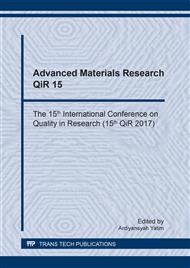p.103
p.109
p.116
p.121
p.128
p.136
p.142
p.150
p.158
Hydrogen Recovery from Hydrogen-Methane Gas Mixture Utilized by Palm Shell Based Bioadsorbent Activated Carbon
Abstract:
The objective of the study is to obtain suitable adsorbent to be applied for the purification of hydrogen from hydrogen-methane gas mixture. The application will be used to increase the efficiency of process in refinery unit focusing on hydrogen supply as the feed of hydrocracking unit. One of the promising technology is adsorption. In this study, adsorbent used is utilized by palm shell based bioadsorbent activated carbon which is a potential raw material among others due to its carbon and lignin content also its abundant supply. The activated carbon is going through chemical activation using H3PO4 to increase its surface area. Characteristic test of produced activated carbon is measured to obtain surface area which resulted in BET surface area of 414.91 m2/g and iodine number of 716 mg/g. In this case, a detailed experimental study has been made for the adsorption of pure methane, and pure hydrogen at 20°C and CH4/H2 gas mixture at 10, 20, and 30°C isothermal condition with pressure variation for each isothermal condition 1 – 6 bar. Measurement were made using volumetric technique coupled with gas chromatographic analysis. The result of adsorption test shows at 20°C adsorption of pure CH4 was highest followed by mixture gas of CH4/H2 with 1.5% methane then pure H2. The adsorption of gas mixture for any composition of gas were increased with increasing pressure at all temperatures. At the same pressure, adsorption of gas mixture that composed of 8.5% methane at 10 and 30°C increased in lower isothermal condition. Based on gas chromatograph analysis, in all conditions methane in gas mixture is all adsorbed to activated carbon. The trend of isothermal adsorption also fits the Langmuir model of isothermal adsorption.
Info:
Periodical:
Pages:
128-135
Citation:
Online since:
August 2018
Authors:
Keywords:
Price:
Сopyright:
© 2018 Trans Tech Publications Ltd. All Rights Reserved
Share:
Citation:


